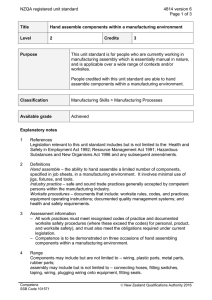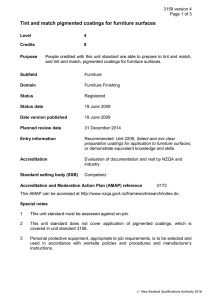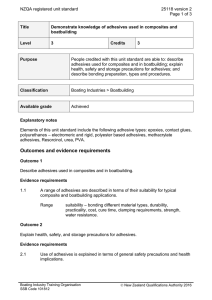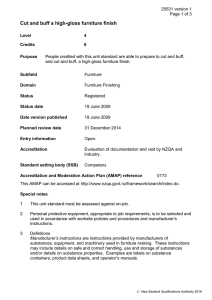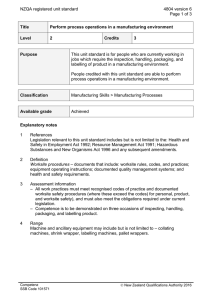Demonstrate knowledge of and use adhesives in furniture making
advertisement
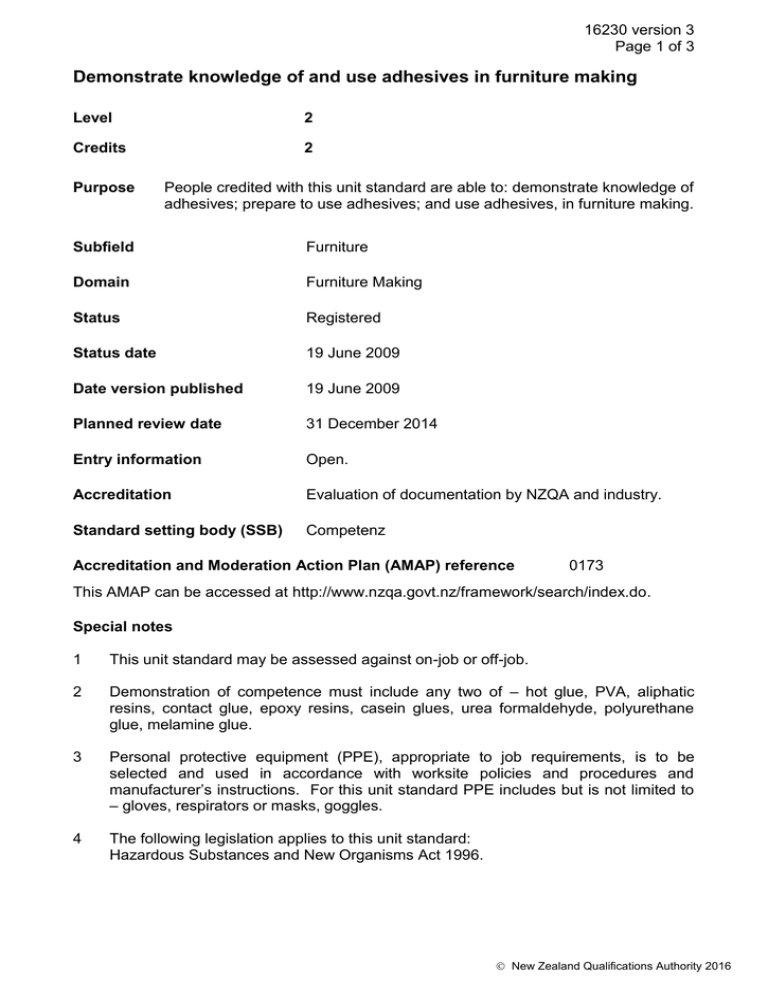
16230 version 3 Page 1 of 3 Demonstrate knowledge of and use adhesives in furniture making Level 2 Credits 2 Purpose People credited with this unit standard are able to: demonstrate knowledge of adhesives; prepare to use adhesives; and use adhesives, in furniture making. Subfield Furniture Domain Furniture Making Status Registered Status date 19 June 2009 Date version published 19 June 2009 Planned review date 31 December 2014 Entry information Open. Accreditation Evaluation of documentation by NZQA and industry. Standard setting body (SSB) Competenz Accreditation and Moderation Action Plan (AMAP) reference 0173 This AMAP can be accessed at http://www.nzqa.govt.nz/framework/search/index.do. Special notes 1 This unit standard may be assessed against on-job or off-job. 2 Demonstration of competence must include any two of – hot glue, PVA, aliphatic resins, contact glue, epoxy resins, casein glues, urea formaldehyde, polyurethane glue, melamine glue. 3 Personal protective equipment (PPE), appropriate to job requirements, is to be selected and used in accordance with worksite policies and procedures and manufacturer’s instructions. For this unit standard PPE includes but is not limited to – gloves, respirators or masks, goggles. 4 The following legislation applies to this unit standard: Hazardous Substances and New Organisms Act 1996. New Zealand Qualifications Authority 2016 16230 version 3 Page 2 of 3 5 Definitions Manufacturer’s instructions are instructions provided by manufacturers of substances, equipment, and machinery used in furniture making. These instructions may include details on safe and correct handling, use and storage of substances and/or details on substance properties. Examples are labels on substance containers, product data sheets, and operator’s manuals. Material Safety Data Sheets (MSDS) are documents containing information on toxic substances used in the worksite. It is a requirement of the Environmental Risk Management Authority that all worksites using toxic substances have an MSDS. Worksite policies and procedures refer to documented policies and to documented or other directions provided to staff. These may include, but are not limited to, ways of managing health and safety, environmental considerations, quality, and production, and must conform to legislation. Examples include standard operating procedures, company health and safety plans, on-site briefings, and supervisor’s instructions. For the purposes of this unit standard worksite policies and procedures may also refer to the policies and procedures of an off-job training site. Elements and performance criteria Element 1 Demonstrate knowledge of adhesives used in furniture making. Performance criteria 1.1 Adhesives are explained in terms of a suitable use in furniture making. Range hot animal glue, PVA, aliphatic resin, contact glue, epoxy resin, casein glue, hot melt adhesive urea formaldehyde, polyurethane, melamine glue. 1.2 At least two adhesives available in the worksite are identified and the requirements for safe handling of these adhesives are explained in accordance with MSDS. 1.3 Two adhesives available in the worksite are compared and an advantage of using each one over the other is explained. Element 2 Prepare to use adhesives in furniture making. Performance criteria 2.1 Job specifications are obtained and explained in accordance with worksite policies and procedures. Range 2.2 material type, number of items. Equipment and materials are selected in accordance with job specifications. New Zealand Qualifications Authority 2016 16230 version 3 Page 3 of 3 2.3 Materials are checked for defects and any defects are identified and marked, and any defective materials are omitted in accordance with job specifications. 2.4 Adhesives are selected in accordance with job specifications. 2.5 Safety precautions to be taken when using selected adhesives are explained in accordance with MSDS. 2.6 Adhesives and application equipment are prepared in accordance with manufacturer’s instructions. Element 3 Use adhesives in furniture making. Performance criteria 3.1 The atmospheric conditions for gluing are in accordance with manufacturer’s instructions. 3.2 Adhesives are applied in accordance with manufacturer’s instructions and MSDS. 3.3 Equipment is cleaned and stored, and adhesives are stored, in accordance with worksite policies and procedures and MSDS. 3.4 Work area is left clean, clear, and safe in accordance with worksite policies and procedures. Please note Providers must be accredited by NZQA, or an inter-institutional body with delegated authority for quality assurance, before they can report credits from assessment against unit standards or deliver courses of study leading to that assessment. Industry Training Organisations must be accredited by NZQA before they can register credits from assessment against unit standards. Accredited providers and Industry Training Organisations assessing against unit standards must engage with the moderation system that applies to those standards. Accreditation requirements and an outline of the moderation system that applies to this standard are outlined in the Accreditation and Moderation Action Plan (AMAP). The AMAP also includes useful information about special requirements for organisations wishing to develop education and training programmes, such as minimum qualifications for tutors and assessors, and special resource requirements. Comments on this unit standard Please contact the Competenz at info@competenz.org.nz if you wish to suggest changes to the content of this unit standard. New Zealand Qualifications Authority 2016


